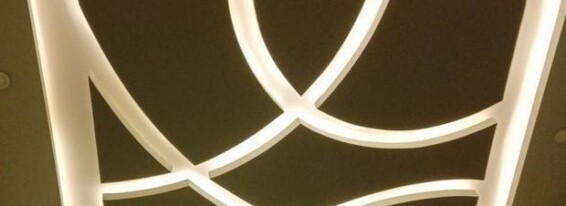Unique Ceiling Designs

Unique ceiling designs refer to creative, stylish, and innovative approaches to designing the overhead space of a room or building. Ceilings often get overlooked during interior design, but a thoughtfully designed ceiling can transform the atmosphere of a space, adding character, texture, and visual interest. From modern minimalist styles to intricate, classic designs, a unique ceiling can make a significant impact on the overall aesthetic of a room.
Types of Unique Ceiling Designs:
1. Coffered Ceilings
- Description: A coffered ceiling features recessed panels, often in a grid pattern, which create a sense of depth and texture. Traditionally, coffering was used in luxury spaces like churches and palaces.
- Materials: Wood, plaster, or a combination of both.
- Benefits: Adds sophistication and elegance to a room. Coffered ceilings are also great for hiding wires or other structural elements.
- Ideal for: Living rooms, dining rooms, and offices.
2. Tray Ceilings
- Description: A tray ceiling, also known as an inverted or recessed ceiling, has a center portion that is higher than the surrounding edges, creating a “tray-like” effect.
- Materials: Commonly made of drywall, but can be enhanced with wood panels, LED lighting, or crown molding.
- Benefits: Adds a sense of spaciousness and depth to a room. The raised center also provides an opportunity for unique lighting designs, like recessed or ambient lighting.
- Ideal for: Bedrooms, living rooms, and dining areas.
3. Vaulted Ceilings
- Description: Vaulted ceilings are high ceilings with a sloping or arched design, often seen in churches, cathedrals, and large living spaces. They create a dramatic and expansive feel.
- Materials: Wood beams, drywall, plaster, and steel for structural support.
- Benefits: Makes a room feel larger and more open. It can make even a small space feel grand.
- Ideal for: Living rooms, entryways, and kitchens.
4. Exposed Beam Ceilings
- Description: This design keeps the beams exposed rather than concealing them, often used in industrial or rustic-style interiors. The beams can be made from wood, steel, or concrete.
- Materials: Wood, steel, or reclaimed timber.
- Benefits: Adds a warm, rustic, or industrial touch. Exposed beams can help create a more natural, earthy vibe, and they’re ideal for open-plan spaces.
- Ideal for: Loft apartments, living rooms, or kitchens in modern and rustic homes.
5. Stretch Ceilings
- Description: Stretch ceilings are made of a flexible material (typically PVC) that is stretched across a frame. The surface is smooth, glossy, and can be customized with various designs, colors, and even prints.
- Materials: PVC, fabric.
- Benefits: Offers a smooth, sleek look and can be designed with unique finishes (matte, glossy, satin). It’s also highly customizable with printed designs, lighting integration, and colors.
- Ideal for: Modern, contemporary spaces, or commercial environments like restaurants, retail stores, or offices.
6. Tin or Metal Ceilings
- Description: Tin ceilings are made from embossed metal panels that add texture and a vintage, industrial look. This type of ceiling design is especially popular in heritage or retro-style interiors.
- Materials: Tin, aluminum, copper, or steel.
- Benefits: Provides texture, and is both durable and easy to maintain. It also adds a vintage charm, often paired with other retro design elements.
- Ideal for: Restaurants, bars, loft apartments, or vintage-styled living rooms.
7. Wood Panel Ceilings
- Description: Wooden ceiling panels create a warm, inviting atmosphere. Depending on the wood species and finish, the ceiling can feel contemporary or rustic. This style is versatile and can be applied to both modern and traditional designs.
- Materials: Natural wood, plywood, MDF.
- Benefits: Adds warmth and texture, ideal for creating a cozy, inviting atmosphere. Wood also has natural acoustic properties, reducing noise.
- Ideal for: Living rooms, home offices, bedrooms, and even bathrooms (with water-resistant finishes).
8. Gypsum or Plaster Ceilings
- Description: Plaster or gypsum ceilings are versatile and can be molded into various intricate shapes, such as curves, flowers, geometric patterns, or even artistic designs. This is especially common in high-end, traditional, or classical interiors.
- Materials: Plaster, gypsum board, moldings.
- Benefits: Provides flexibility in design and is highly customizable. Decorative plasterwork can give a room a timeless, luxurious feel.
- Ideal for: Grand entryways, living rooms, and bedrooms in luxury or classical homes.
9. Skylights and Glass Ceilings
- Description: Skylights or glass ceilings allow natural light to flow into the room from above. They can be large or small windows placed in the roof or an entire glass ceiling.
- Materials: Glass, acrylic, polycarbonate.
- Benefits: Maximize natural light, making a space feel airy and open. They can be fixed or operable, and in modern homes, they can incorporate advanced insulation and UV protection.
- Ideal for: Kitchens, bathrooms, sunrooms, and contemporary homes.
10. LED Lighting Integrated Ceilings
- Description: LED lights integrated into the ceiling can highlight certain features or provide ambient lighting. These lights can be recessed into the ceiling, incorporated into coves, or used to accentuate a unique design like a coffered or tray ceiling.
- Materials: LED strips, recessed lights, lighting panels.
- Benefits: Provides modern lighting solutions while saving energy. The integration of lighting into the ceiling can create stunning visual effects, like indirect or accent lighting.
- Ideal for: Modern living rooms, kitchens, home theaters, and offices.
11. Geometric or Abstract Ceiling Patterns
- Description: Some designers take a more artistic approach with geometric or abstract ceiling designs, featuring bold patterns, contrasting colors, and unexpected shapes. This may include shapes like hexagons, triangles, or abstract forms.
- Materials: Paint, wood panels, plaster, or 3D wall panels.
- Benefits: Adds a modern, bold statement to the room, making the ceiling itself a focal point. It’s ideal for contemporary homes and creative spaces.
- Ideal for: Modern offices, art studios, creative lounges, and living rooms.
12. 3D Ceilings
- Description: A 3D ceiling is designed to create a sense of depth and dimension, often using textured panels or geometric patterns. These ceilings can be made from materials like gypsum, plaster, or even wood.
- Materials: Gypsum, MDF, PVC panels, and metal.
- Benefits: The tactile nature of the ceiling adds visual intrigue and depth, often making the room feel more dynamic.
- Ideal for: Living rooms, bedrooms, offices, and spaces where you want to create a strong design impact.
